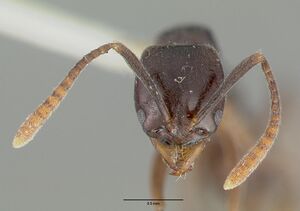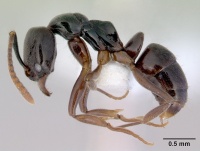Brachyponera croceicornis
| Brachyponera croceicornis | |
|---|---|

| |
| Scientific classification | |
| Kingdom: | Animalia |
| Phylum: | Arthropoda |
| Class: | Insecta |
| Order: | Hymenoptera |
| Family: | Formicidae |
| Subfamily: | Ponerinae |
| Tribe: | Ponerini |
| Genus: | Brachyponera |
| Species: | B. croceicornis |
| Binomial name | |
| Brachyponera croceicornis (Emery, 1900) | |
| Synonyms | |
| |
Identification
Keys including this Species
Distribution
Latitudinal Distribution Pattern
Latitudinal Range: -3.089444444° to -17.68°.
| North Temperate |
North Subtropical |
Tropical | South Subtropical |
South Temperate |
- Source: AntMaps
Distribution based on Regional Taxon Lists
Australasian Region: Australia (type locality).
Indo-Australian Region: New Guinea (type locality), Philippines, Solomon Islands.
Distribution based on AntMaps
Distribution based on AntWeb specimens
Check data from AntWeb
Countries Occupied
| Number of countries occupied by this species based on AntWiki Regional Taxon Lists. In general, fewer countries occupied indicates a narrower range, while more countries indicates a more widespread species. |

|
Estimated Abundance
| Relative abundance based on number of AntMaps records per species (this species within the purple bar). Fewer records (to the left) indicates a less abundant/encountered species while more records (to the right) indicates more abundant/encountered species. |

|
Biology
Castes
Worker
       
| |
| . | |
Nomenclature
The following information is derived from Barry Bolton's Online Catalogue of the Ants of the World.
- bicolor. Ponera bicolor Donisthorpe, 1949b: 492 (w.) NEW GUINEA (Indonesia).
- [Unresolved junior primary homonym of Ponera bicolor Guérin-Méneville, 1844a: 424 (Bolton, 1995b: 303).]
- Status as species: Chapman & Capco, 1951: 68.
- Junior synonym of croceicornis: Wilson, 1958d: 347; Bolton, 1995b: 303.
- inops. Euponera (Brachyponera) luteipes subsp. inops Forel, 1910b: 17 (w.) AUSTRALIA (Queensland).
- Subspecies of luteipes: Emery, 1911d: 84.
- Junior synonym of croceicornis: Wilson, 1958d: 347; Taylor, 1987a: 9; Bolton, 1995b: 306.
Type Material
- Euponera (Brachyponera) luteipes croceicornis Emery, 1900: Syntype, worker(s), queen(s), New Guinea, museum unknown (prob. MCSN (Genoa) or HNHM (Budapest)).
- Euponera (Brachyponera) luteipes inops Forel, 1910: Syntype, worker(s), Kuranda near Cairns, Queensland, Australia, Musee d'Histoire Naturelle Genève.
Description
References
- Boudinot, B.E., Richter, A., Katzke, J., Chaul, J.C.M., Keller, R.A., Economo, E.P., Beutel, R.G., Yamamoto, S. 2022. Evidence for the evolution of eusociality in stem ants and a systematic revision of †Gerontoformica (Hymenoptera: Formicidae). Zoological Journal of the Linnean Society XX:1-35 (doi:10.1093/zoolinnean/zlab097/6523228).
- Brown, W. L., Jr. 1995a. [Untitled. Taxonomic changes in Pachycondyla attributed to Brown.] Pp. 302-311 in: Bolton, B. A new general catalogue of the ants of the world. Cambridge, Mass.: Harvard University Press, 504 pp. (page 304, Combination in Pachycondyla)
- Emery, C. 1900b. Formicidarum species novae vel minus cognitae in collectione Musaei Nationalis Hungarici quas in Nova-Guinea, colonia germanica, collegit L. Biró. Publicatio secunda. Természetr. Füz. 23: 310-338 (page 315, worker, queen described)
- Esteves, F.A., Fisher, B.L. 2021. Corrieopone nouragues gen. nov., sp. nov., a new Ponerinae from French Guiana (Hymenoptera, Formicidae). ZooKeys 1074, 83–173 (doi:10.3897/zookeys.1074.75551).
- Richter, A., Boudinot, B.E., Hita Garcia, F., Billen, J., Economo, E.P., Beutel, R.G. 2023. Wonderfully weird: the head anatomy of the armadillo ant, Tatuidris tatusia (Hymenoptera: Formicidae: Agroecomyrmecinae), with evolutionary implications. Myrmecological News 33: 35-75 (doi:10.25849/MYRMECOL.NEWS_033:035).
- Schmidt, C.A. & Shattuck, S.O. 2014. The higher classification of the ant subfamily Ponerinae (Hymenoptera: Formicidae), with a review of ponerine ecology and behavior. Zootaxa 3817, 1–242 (doi:10.11646/zootaxa.3817.1.1).
- Wilson, E. O. 1958g. Studies on the ant fauna of Melanesia III. Rhytidoponera in western Melanesia and the Moluccas. IV. The tribe Ponerini. Bulletin of the Museum of Comparative Zoology 119: 303-371 (page 347, Combination in Brachyponera, Raised to species, and senior synonym of bicolor and inops)
References based on Global Ant Biodiversity Informatics
- CSIRO Collection
- Donisthorpe H. 1948. A second instalment of the Ross Collection of ants from New Guinea. Annals and Magazine of Natural History (11)14: 297-317.
- Donisthorpe H. 1949. A fifth instalment of the Ross Collection of ants from New Guinea. Annals and Magazine of Natural History (12)1: 487-506.
- Emery C. 1900. Formicidarum species novae vel minus cognitae in collectione Musaei Nationalis Hungarici quas in Nova-Guinea, colonia germanica, collegit L. Biró. Publicatio secunda. Természetrajzi Füzetek 23: 310-338.
- Emery C. 1911. Hymenoptera. Fam. Formicidae. Subfam. Ponerinae. Genera Insectorum 118: 1-125.
- Greenslade P.J.M. and Greenslade Penelope. 1977. Some Effects of Vegetation Cover and Disturbance on a Tropical Ant Fauna. Insectes Sociaux 24(2): 163-182
- Greenslade P.J.M. and P. Greenslade. 1977. Some effects of vegetation cover and disturbance on a tropical ant fauna. Insectes Sociaux 24(2): 163-182.
- Janda M., G. D. Alpert, M. L. Borowiec, E. P. Economo, P. Klimes, E. Sarnat, and S. O. Shattuck. 2011. Cheklist of ants described and recorded from New Guinea and associated islands. Available on http://www.newguineants.org/. Accessed on 24th Feb. 2011.
- Klimes P., P. Fibich, C. Idigel, and M. Rimandai. 2015. Disentangling the diversity of arboreal ant communities in tropical forest trees. PLoS ONE 10(2): e0117853. doi:10.1371/journal.pone.0117853
- Lucky A., E. Sarnat, and L. Alonso. 2011. Ants of the Muller Range, Papua New Guinea, Chapter 10. In Richards, S. J. and Gamui, B. G. (editors). 2013. Rapid Biological Assessments of the Nakanai Mountains and the upper Strickland Basin: surveying the biodiversity of Papua New Guineas sublime karst environments. RAP Bulletin of Biological Assessment 60. Conservation International. Arlington, VA.
- Lucky A., K. Sagata, and E. Sarnat. 2011. Ants of the Nakanai Mountains, East New Britain Province, Papua New Guinea, Chapter 1. In Richards, S. J. and Gamui, B. G. (editors). 2013. Rapid Biological Assessments of the Nakanai Mountains and the upper Strickland Basin: surveying the biodiversity of Papua New Guineas sublime karst environments. RAP Bulletin of Biological Assessment 60. Conservation International. Arlington, VA.
- Lucky A., L. E. Alonso, E. Sarnat, and J. Hulr. 2015. Ants and scolytine beetles. In: Richards, S.J. and N. Whitmore (editors) 2015. A rapid biodiversity assessment of Papua New Guinea's Hindenburg Wall region. Wildlife Conservation Society Papua New Guinea Program. Goroka, PNG.
- Mann W. M. 1919. The ants of the British Solomon Islands. Bulletin of the Museum of Comparative Zoology 63:273-391.
- Mann, W.M. 1919. The ants of the British Solomon Islands. Bulletin of the Museum of Comparative Zoology of Harvard College 63: 273-391
- Room P. M. 1975. Diversity and organization of the ground foraging ant faunas of forest, grassland and tree crops in Papua Nez Guinea. Aust. J. Zool. 23: 71-89.
- Room, P.M. 1975. Relative Distributions of Ant Species in Cocoa Plantations in Papua New Guinea Relative Distributions of Ant Species in Cocoa Plantations in Papua New Guinea. Journal of Applied Ecology 12(1):47-61
- Snelling R. R. 1998. Insect Part 1: The social Hymenoptera. In Mack A. L. (Ed.) A Biological Assessment of the Lakekamu Basin, Papua New Guinea, RAP 9. 189 ppages
- Snelling R. R. 2000. Ants of the Wapoga river area, Irian Jaya, Indonesia. In Mack, Andrew L. and Leeanne E. Alonso (eds.). 2000. A Biological Assessment of the Wapoga River Area of Northwestern Irian Jaya, Indonesia. RAP Bulletin of Biological Assessment 14, Conservation International, Washington, DC.
- Taylor R. W. 1987. A checklist of the ants of Australia, New Caledonia and New Zealand (Hymenoptera: Formicidae). CSIRO (Commonwealth Scientific and Industrial Research Organization) Division of Entomology Report 41: 1-92.
- Viehmeyer H. 1912. Ameisen aus Deutsch Neuguinea gesammelt von Dr. O. Schlaginhaufen. Nebst einem Verzeichnisse der papuanischen Arten. Abhandlungen und Berichte des Königlichen Zoologischen und Anthropologische-Ethnographischen Museums zu Dresden 14: 1-26.
- Viehmeyer H. 1914. Papuanische Ameisen. Deutsche Entomologische Zeitschrift 1914: 515-535.
- Wilson E. O. 1958. Studies on the ant fauna of Melanesia III. Rhytidoponera in western Melanesia and the Moluccas. IV. The tribe Ponerini. Bulletin of the Museum of Comparative Zoology 119: 303-371.
- Wilson Edward O. 1959. Adaptive Shift and Dispersal in a Tropical Ant Fauna. Evolution 13(1): 122-144

